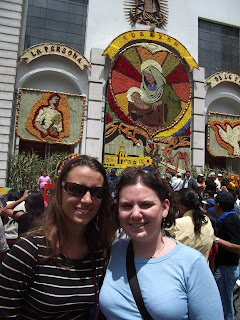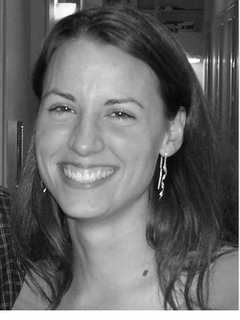Ron and Gloria's team had the most "global" experience (through Habitat for Humanity and otherwise) of any other team with which I worked, and I LOVED their stories of travel, life and gumption!
.JPG)
(The picture above shows Ron and Gloria speaking on behalf of their Global Village team, the photo below includes the team, family, local Habitat employees and the site's "maestro" and family).
.JPG)
What an energetic and positive group they were! Ron was leading his 13th Global Village group! He had taken groups to various locations in Mexico, to Poland, Thailand, India and...? He and his wife, Gloria, worked as a team to lead this particular large team of 17 that had an average age of 65! The majority of the team was from the San Francisco area, and I look forward to visiting them:-). Most of the members had traveled with Ron and Gloria before on one of their past 13 trips.
Here are two members of the team, Diana and Howard. They also lead Habitat trips.
.JPG)
Ron's team, all 17 of them, were assigned to one house building site, a huge task-management challenge-- even though they should have had two houses on which to work. To make matters worse, this particular site had many hazards including mischievous, but cute children, barbed wire, confined space, bad access, a puppy named Felipe, uneven ground, mud and a ditch. The second house site, which was supposed to be ready for the team, had some sort of legal delay based on the proprietary paperwork for the house.
Here are the mischievous children (the girl with bangs is Brianiz, and was particularly in need of attention... however she could get it).
.JPG)
Thanks to the great attitudes of the team, the forward thinking of their leaders, and the talented on-site maestro-Jose- they prevailed in maintaining a consistent flow of work and positive attitudes.
.JPG)
We were building the house from ground up and the team volunteered for 7.5 workdays: 5 in one week and 2.5 the next week.
The family we built for consisted of a mother, her mother, several children and some grandchildren. They would likely be keeping the bamboo house that already existed on the lot, in addition to the new 36 meter square concrete house we were building. Here is a picture of the mother, her mother and her son with his dog Felipe.
.JPG)
The mother's mother was rather senile, but she had a great appreciation for the volunteers. She kept talking about how beautiful they were and how beautiful what they were doing was. The son included in this picture was the family's representative volunteer on-site all week, however he lived a few streets away with his wife (who also helped out on site).
.JPG)
The work that week in January was hot and arduous. Santo Domingo had entered its full rainy season since the last time I had been there, and that meant that almost every day we received rain.
.JPG)
That meant that every day we dealt with more mud! On the bright side, the landscape was beautiful: green and lush.
.JPG)
Ron and Gloria's team had to be creative in their work: materials had to be dropped off down a hill and around a corner, so everything had to be moved multiple times.
.JPG)
First things were moved to be out of the way when they were dropped off. Then they were moved to be worked with, then, in the case of the cement, it had to be moved a third time to be turned into the footings, foundation and columns. We used a lot of human chains, wheelbarrow relays and assembly-line style mechanisms in order to take advantage of our numbers.
.JPG)
To make matters more complicated, all tools and supplies had to be moved into storage each night... BEHIND the house and work area. Then each morning the supplies were removed again. Santo Domingo de los Colorados is known for its high levels of crime (particularly theft).
.JPG) t
t Here is our "maestro" (teacher) Jose with his two daughters, Erica and Marienela, leaving the work site for the day.
.JPG)
I straighted nails for the first time in Ecuador with this group. We don't use a lot of framing for the houses, but the structures that form the columns' frames and the raised frames for the foundation can be reused.
.JPG)
Here the columns are formed.
.JPG)
Here the team sifts sand to be used in a mortar mixture.
.JPG)
Then blocks were laid with the mortar.
.JPG)
We had some very hard-working concrete mixers, one of whom constantly advised the group that the cement would not pass the rigorous and telling "slump test."
.JPG)
After this group, I will never forget about the concept of a slump test. The concrete we were mixing was very watery, however the teams must accept local building practices when working with Global Village.
Oh... what a pesky, pesky child!
.JPG)

.JPG)
.JPG)
.JPG)

.JPG)

.JPG)
.JPG)
.JPG)
.JPG)
.JPG)


.JPG)

.JPG)
.JPG)
.JPG)
.JPG)
.JPG)
.JPG)
.JPG)
.JPG)
.JPG)
